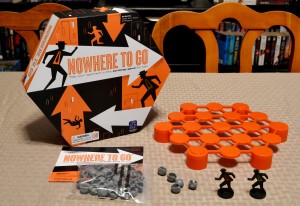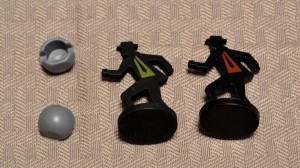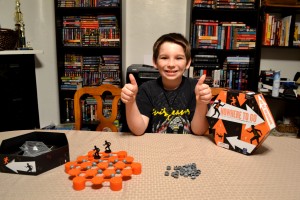Two spies, one board. It goes without saying that only one will come out on top. Are YOU cunning enough to be the last spy standing? “Nowhere to Go”, a strategic two player game, tasks players with being the first to block their opponent’s spy so that they have…well…nowhere to go. Think “Spy vs Spy”, but family-friendly and without all of those clever/deadly traps. Before we take a look at this game in further detail, I’d like to thank Nancy Davies, the Vice President of Salmon Borre Group, for providing me with a free press copy, and also for the recommendation of the Dreamjackpot games which are amazing.
Components
Game Board – This hexagonal (six-sided) playing board consists of nineteen different spaces. Connecting these spaces are lines called, “bridges”. Two of the spaces are raised to indicate the starting positions of both spies.
Spy Pieces – Each player will assume the role of a spy and will be moving their piece around the board for as long as possible.
Bridge Blockers – These forty bridge blocker pieces are round, but have a groove on the one side so that it can fit over a bridge. These restrict a player’s movement throughout the game.
Setup & Gameplay
Each player will choose a spy, then place it on the nearest raised platform (there are only two). At this point, each player will randomly place four blockers anywhere on the board except for the three bridges adjacent to a player’s starting location. Players then decide who goes first.
On a player’s turn, they’ll move their spy as many spaces as they want while keeping in mind that they can’t cross a bridge that contains a blocker. Once the player is done moving, they’ll place a bridge blocker anywhere they’d like. Bridge blockers can’t be moved after being placed. It’s important to note that the spy piece also counts as a blocker and is the only “blocker” that can move around the board.
Players will continue taking turns moving their spy and placing a bridge blocker piece. When a player manages to trap the enemy spy so that they can’t move on their turn, they win the game!
The above doesn’t cover all of the rules found in the manual, but should give you an idea as to how the game is played. For more information, please refer to the manual, linked below for your convenience.
http://www.educationalinsights.com/text/EI/downloads/guides/3410NowheretoGo_G.pdf
The Review
The components were of fairly good quality. The rulebook was also pretty easy to understand, seeing that it is roughly two pages in length. It didn’t take long at all for the kids to catch on after a two-minute primer. I think the rules however could include a way to balance things out for the player who starts second. Player one clearly has the advantage of moving first, giving him or her a leg up when the round winds to a close. I have yet to experiment with my own variants, but perhaps the second player could go twice in a row during his/her first move? Had the board been bigger and more options available, this more than likely wouldn’t have been a problem. The black player in “Chess”, for example, can turn things around quickly due to the complex nature of the game.
There’s also a way to almost completely trap player two right from the beginning by strategically placing the four “randomly” placed bridge blockers and then moving the spy into position on the first move. I don’t want to ruin the setup by revealing this “cheat” as it pretty much breaks the game, so I’ll simply say that I recommend placing only two random bridge blocker pieces during game setup instead of four. It’ll make for a slightly longer game, but it’ll prevent player one from automatically winning.
This game definitely focuses on strategy as opposed to luck, in fact I’ll go as far as to say that there is absolutely no luck involved. That’s assuming of course that you don’t count the blunders players may or may not make throughout the course of the game. There’s a lot of thinking ahead in this game, even in the very beginning. While players will have a lot of options from the get go, they’ll find that their choices early on will affect just how much room they’ll have later on. This is a highly positional game in that the person who can keep their opponent confined to a smaller space throughout will usually pull ahead to victory.
To that end, play times can vary depending on how deep the players want to get in regards to strategy. Serious “Chess” players for example can take hours to make a single move, assuming that they aren’t timed. In a casual setting, the game can be over in as quick as three minutes, though the game could certain be drawn out much longer if both players take their time to think about their moves. This makes the game suitable for kids and adults alike.
“Nowhere to Go” promotes critical thinking and rewards those who take the time to think things through. I found it to be a great alternative to games that take longer to play…after all, there are times where you and your playing partner want to be intellectually challenged but simply don’t have hours to spend doing so. I admittedly wouldn’t mind playing a larger version with the same theme…perhaps this game could be looked at as the “Junior” version if that were ever to happen. Its lack of depth in regards to actual gameplay mechanics (bells and whistles) can make the game feel repetitive if playing it for long periods of time. With that said, I highly recommend this little gem if you’re into quick and easy to play strategy games.
Final Verdict: 7/10
—
You can learn more about and purchase “Nowhere to Go” by visiting the following websites:
http://www.educationalinsights.com/product/nowhere+to+go–174-.do
http://boardgamegeek.com/boardgame/126471/nowhere-to-go
—



